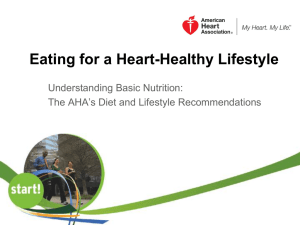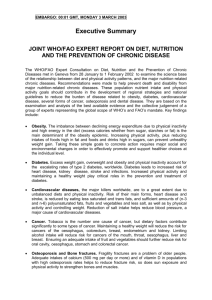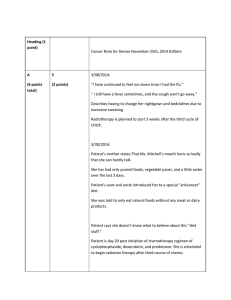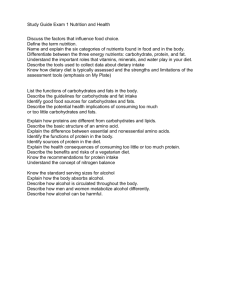Nutritional Foundations for Youth Performance
advertisement
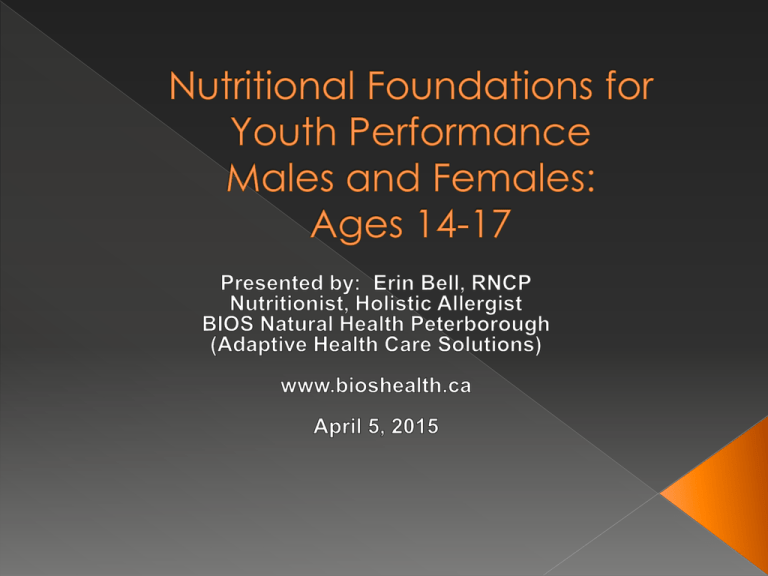
The mass marketing and media hype of “diets” provides more confusion and sets up the platform for “nutritional failure” usually resulting in malnutrition. We are not underfed, we are undernourished. Despite being the main form of energy for humans… Nutrition is still poorly understood. According to the most recent Canadian Community Health Survey, done in 2004, 53 percent of males aged 14 to 18 are not getting the minimum number of servings of vegetables and fruit on a daily basis. Among the girls, 63 percent consumed less than the bare minimum The minimum in 2004 was five servings of vegetables and fruit, combined, but has since been upped to seven servings for teen girls and eight for teen boys. (Source: alive Magazine, Sept. 2013) 52% of teen boys are overweight or obese and 44% of teen girls are overweight or obese. Today’s youth are set to face diseases such as cancer, cardiovascular disease, and diabetes well before the previous generation. “Mmm… Yummy!” Anxiety PAIN! Drugs Genetic Problems Depression Inflammation Disease Medications You are Here! Essential nutrients - proteins, carbohydrates, fats and oils, minerals, vitamins, and water. Diet is what we eat, but nutrition is what our cells and tissues actually require to function properly. The digestive system’s main function is to convert food into ENERGY useful for the body and to provide for waste removal. This energy is used at the CELLULAR level to provide nutrients used for the chemical reactions the body requires to maintain life. The digestive system houses the largest part of the IMMUNE System! There are specific ages in both boys and girls where specific athletic abilities will adapt or respond to a training catalyst (stimulus): Strength: Females ages 11-13 Speed: Females ages 11-13 Skill: Females ages 8-11 Endurance: Females age 12 (PHV*) Flexability: Males ages 9-12 and 14-18 Males ages 13-16 Males ages 9-12 Males ages (12) 14 Typically around ages 6-10 for both groups. *Peak Height Velocity: maximum rate of growth in stature during a growth spurt. Optimum Nutrition is required for peak performance and recovery. It is important to remember that children of all ages develop in these areas at different rates: Physical Emotional Cognitive Motor skills Perception Chronological Age (actual years) can differ significantly from Biological Age (development). Goal Setting – setting achievable goals and future goals in sports. Practicing and improving technique and selfconfidence. Relaxation and stress management skills. Learning rest and recovery techniques. Mental skills to deal with competition. Patience and self-control. Developing concentration. Time management skills. Promoting positive reinforcement and self image. This circadian cycle is “synchronized” to regulate various physiological and behavioral processes of the body. Nearly all of these processes in humans occur rhythmically. Our body is programmed to “do the right thing at the right time of day”. HGH (human growth hormone) is specifically active while we sleep to restore, replace and repair cellular damage. Basically, we GROW while we sleep! Although we can adapt somewhat to changes in our external environment, we cannot sustain this system if it is regularly interrupted. Some other processes involved in circadian rhythm are co-ordination, body temperature, alertness, neurological processes, cellular growth and regeneration, and digestion. The entire system “resets” itself every 24 hours. Long term disruption to this cycle has shown significant adverse health effects specifically to the cardiovascular system as well as increases in the risk of developing cancer. Teens are entering a very blood sugar), early or late challenging stage of life. sexual maturation, hyperactivity, lethargy and Emotional and psychological learning disabilities. issues can be overwhelming, especially when the stages of Emotional and psychological competition are introduced. demands, as well as increased physical activity Performance anxiety is uses more of the essential common at this stage. nutrients from foods. Nutrient deficiencies, Health Statistics show a direct specifically in B Vitamins, co-relation between nutrient Magnesium and Essential deficiencies and mental and Fatty Acids have been cognitive function. scientifically proven in conditions of depression, ADD/ADHD, OCD, Autism, delayed growth, behavioral and social disorders, mood swings, hypoglycemia (low Teens with nutritional growth impediment may experience growth deceleration due to suboptimal energy intake. Protein intake may be inadequate and is often the cause of growth delay. This can result in energy malnutrition. Insufficient protein intake due to injury or illness, as well as heavy exercise may be temporarily delayed, but can quickly catch up after sufficient dietary protein is consumed. Today’s SAD diet (standard American/Western Diet) is carbohydrate heavy and is generally lacking in sufficient protein for optimal growth and development. A child’s genetically determined growth potential can be delayed as an adaptive response of the body to procrastinate growth until optimal dietary energy is achieved. This process must be properly distinguished from other causes of growth delays. In addition, there may be deficiencies in minerals such as zinc and iron, and vitamins, as well as essential fatty acids (omega fatty acids). All may lead to a decrease in physical activity, which is the body’s attempt to decrease further energetic loss. Nutrition, especially dieting behavior, can be a major factor for growth hindrance, particularly in sports that emphasize strict weight control and particularly with psychological and emotional factors involving self-esteem in relation to physical “appearance” which is common in teenage years. Energy balance is crucial to growth and development. This balance can only be obtained through adequate, quality nutrition. Intake of energy in the form of food, as well as vitally important nutrients such as calcium and magnesium may be suboptimal in athletes who restrict dietary intake during a time of increased metabolic activity or with practicing “dieting” due to the desire to be “thin.” SUGAR! 1 teaspoon of sugar can suppress the immune system for up to 6 hours as well as High Fructose Corn Syrup (HFCS) used as a sweetener! WHITE foods and Bad Fats: White bread, white pasta, baked goods,fried foods. Artificial Colors Chemical compounds made from coal-tar derivatives to enhance color. Linked to allergic reactions, fatigue, asthma, skin rashes, hyperactivity and headaches. These are the colorants in sports drinks. Artificial Flavorings Cheap chemical mixtures that mimic natural flavors to allergic reactions, dermatitis, eczema, hyperactivity and asthma. Artificial Sweeteners (Acesulfame-K, Aspartame, Equal®, NutraSweet®, Saccharin, Sweet’n Low®, Sucralose, Splenda® & Sorbitol) Highly-processed, chemically-derived, zerocalorie sweeteners found in diet foods and diet products to reduce calories per serving. Have direct negative impact on metabolism. Some have been linked to cancer, headaches, dizziness and hallucinations. Preservatives (BHT, BHA, TBHQ) Compounds that preserve fats and prevent them from becoming rancid. May result in hyperactivity, angiodema, asthma, rhinitis, dermatitis, tumors and affects hormone activity in the body. Neurotoxicity: these additives can affect nerve function and the transmission of nervous system messages. Delayed growth and development as well as behavioral and learning disabilities. Hormonal imbalances leading to growth, emotional and psychological disturbances and disabilities including delayed sexual maturity. Obesity and metabolic disorders such as diabetes and thyroid issues as well as cardiovascular issues. Respiratory Problems: asthma, respiratory/seasonal allergies. Food Intolerances, allergies and food/chemical sensitivities. Fertility Problems: creating miscarriage, developmental and reproductive problems. Mental and Psychological disorders, mood disorders, phobias. Increased inflammation which affects physical performance. Delayed healing of injuries and delayed recovery of illness. Auto-immune disorders such as fibromyalgia, MS, cancer, Lupus. Approximately 20-30% of the diet should consist of high quality, lean, natural sources of protein. Protein is absolutely necessary for muscle growth and support as well as wound healing. It is necessary for tissue repair. Proteins are like building blocks – they provide the substances the body needs to build muscle. Chronic protein deficiency can result in death. Nuts, seeds and legumes (beans and lentils) are good sources of protein. FAT gets a bad rap most of the time, but not all fat is bad… Many of our organs are actually composed of fatty tissues such as the pancreas and thyroid and adrenal glands Flax seed oil, hemp seed oil, walnut and coconut oil and oily fish are great sources of one of the key essential fatty acids, ALSO called Omega-3 fatty acids. For cooking, choose extra virgin olive oil or coconut oil. Fat should only take up about 10-20 % of daily dietary intake. Good fats provide the body with essential fatty acids for brain development, decreased inflammation and used by the liver to provide good cholesterol for the cells. FOOD SOURCES OF GOOD FATS: nuts, seeds, avocados and the oils listed above. Good quality sources of complex carbohydrates should make up about 30-40% of the daily diet. Oatmeal, whole grains, brown rice, whole grain pasta, and beans are all good sources of complex carbs. Complex carbs are an excellent source of fiber. The difference between good carbs and bad carbs is not based on a simple and complex carbohydrates list. It’s based on how much fiber is in the food and how fast the food’s sugars are absorbed into your blood stream. Complex carbohydrates are absorbed much slower into the blood stream. Simple carbs are refined,sugary foods and white flour based products. These are absorbed quickly and can spike blood sugar levels. Carbohydrates are the primary source of GLUCOSE for the body, and used as fuel both for physical energy and used as the primary source of fuel for the brain. THINK Colour! The colors of fruits and vegetables are there for a reason. They are called antioxidants…basically RUST prevention. Oxidation is a normal part of metabolic function which causes free radical damage in the body. Exercise increases oxidation, however, also increases oxygenation. While oxygen is good, it is also bad if we do not consume enough “antioxidants” to combat the negative effects of oxidation. The “colours” of food represents hundreds of antioxidants used to help prevent free radical damage. Supplements are absolutely essential for every stage of life, however, the word itself means “in addition to”. Supplements DO NOT substitute for a poor diet. No amount of supplements are worth it if your nutritional intake is consistently inadequate. Not all supplements are created equal. Think QUALITY over QUANTITY/VALUE. Children of all ages require supplements especially if they are engaging is sports activities to reduce the potential of deficiencies due to increased metabolic activity. It is best to consult with a Natural Health Practitioner for advice before beginning a supplement protocol. Adequate protein and water (much more preferable over sports drinks) are required before and after sports. Sports drinks are laced with High Fructose Corn Syrup and food dyes, linked to many health problems. Fruits, vegetables, whole grains, nuts and seeds (if not allergic), ancient grains such as kamut, spelt, whole oats. Lean meats, REAL meat, (not processed), eggs, fish, legumes (beans), brown and wild rices, quinoa. AVOID: Excess sugar, fried foods, fast food, fatty foods, candy, packaged/highly processed foods. OPTIMAL PERFORMANCE FOLLOWS THE 80-20 RULE What is a Nutritionist? A nutritionist is a qualified practitioner who has studied nutrition thoroughly and understands that each person has genetically unique nutritional requirements. A nutritionist will consider many factors in counseling an individual that may include age, gender, height / weight, lifestyle, activity level (exercise) and dietary habits, food sensitivities and intolerances as well as food preferences and supplements. Nutrition is not regulated in Canada, and anyone MAY attempt to call themselves a nutritionist, but ONLY those who have studied nutrition thoroughly and passed the testing can use the designation of RNCP (Registered Nutritionist) and register with the IONC (International Organization of Nutritional Consultants). Thank you PCSA and Athletes for attending this Presentation

